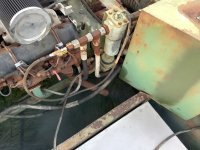arse_sidewards
Red Skull Member
- Joined
- May 19, 2020
- Member Number
- 71
- Messages
- 8,555
The fact that they silicone'd the gaskets rather than just tossing the gaskets using straight sealant makes me think they might be necessary.Question, all this stuff is separated with about 1/16” gaskets. They spread tons of silicone on both sides of the gaskets also. I’m thinking of just bolting together with some “make a gasket” stuff. You don’t suppose they make this stuff with tight tolerances that a 1/16” is going to matter?
Can you not spend 10min fucking around with a 6" caliper to confirm it'll all fit?
Can you stuff something in there so you can see confirm there's clearance like using clay to check valve/piston clearance?
Or maybe stuff something of known length like 2" long and slide it together and measure the gap when it bottoms out and if you've got less than 1-15/16th or so call it good.
It would suck to roach an unobtanium part because something was just barely pressing on something.




